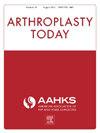Hip Hemiarthroplasty vs Total Hip Arthroplasty for Femoral Neck Fractures: Reverse Fragility of Reoperation Rates in Randomized Controlled Trials
IF 2.1
Q3 ORTHOPEDICS
引用次数: 0
Abstract
Background
Total hip arthroplasty (THA) has theoretical advantages and disadvantages over hemiarthroplasty for femoral neck fractures. Numerous studies have suggested equivalent reoperation rates between the procedures. The purpose of this study was to use the reverse fragility index (RFI) to evaluate the statistical robustness of randomized controlled trials (RCTs) reporting nonsignificant differences in reoperation rates between hip hemiarthroplasty and THA for femoral neck fractures.
Methods
Following Preferred Reporting Items for Systematic Reviews and Meta-Analyses guidelines, all RCTs that compared reoperation rates between THA and hemiarthroplasty for femoral neck fractures were identified. Studies that reported nonsignificant differences in reoperation rates were included. The RFI and patients lost to follow-up were calculated for each study.
Results
We identified 9 RCTs comparing THA and hemiarthroplasty for femoral neck fractures with nonsignificant reoperation rates. The overall median reoperation rate was 6.7%, 7.9% in the hemiarthroplasty group and 5.0% in the THA group. The median RFI was 3, indicating that had the outcome of 3 patients in 1 treatment arm been reversed, the studies' nonsignificant result would change to statistically significant (P < .05). Six of the 9 included studies had a loss to follow-up greater than or equal to the studies' RFI.
Conclusions
The results of clinical trials reporting nonsignificant differences in reoperation rates between hemiarthroplasty and THA for femoral neck fractures would become significant if the outcomes of a few patients were reversed. The number of patients needed to reverse these studies' results was frequently less than those lost to follow-up; thus, the neutrality of these studies is fragile.
Level of Evidence
1.
股骨颈骨折半髋关节置换术与全髋关节置换术:随机对照试验中再手术率的反向脆弱性
背景:与半髋关节置换术相比,全髋关节置换术治疗股骨颈骨折具有理论上的优点和缺点。许多研究表明两种手术之间的再手术率相当。本研究的目的是使用反向脆弱性指数(RFI)来评估随机对照试验(rct)的统计稳健性。随机对照试验(rct)报告了半髋关节置换术与THA治疗股骨颈骨折的再手术率无显著差异。方法根据系统评价和荟萃分析指南的首选报告项目,确定所有比较全髋关节置换术和股骨颈骨折半关节置换术再手术率的随机对照试验。纳入了报道再手术率无显著差异的研究。计算每项研究的RFI和失去随访的患者。结果我们确定了9项随机对照试验,比较THA和半关节置换术治疗股骨颈骨折的再手术率无显著性差异。整体中位再手术率为6.7%,半关节置换术组为7.9%,THA组为5.0%。RFI中位数为3,表明如果1个治疗组中有3例患者的结局发生逆转,则研究无统计学意义的结果变为具有统计学意义(P < 0.05)。纳入的9项研究中有6项随访损失大于或等于研究的RFI。结论:一些临床试验报告的股骨颈骨折半关节置换术与全髋关节置换术在再手术率上无显著差异的结果,如果少数患者的预后发生逆转,则具有显著性。需要逆转这些研究结果的患者数量往往少于随访失败的患者;因此,这些研究的中立性是脆弱的。证据水平
本文章由计算机程序翻译,如有差异,请以英文原文为准。
求助全文
约1分钟内获得全文
求助全文
来源期刊

Arthroplasty Today
Medicine-Surgery
CiteScore
2.90
自引率
0.00%
发文量
258
审稿时长
40 weeks
期刊介绍:
Arthroplasty Today is a companion journal to the Journal of Arthroplasty. The journal Arthroplasty Today brings together the clinical and scientific foundations for joint replacement of the hip and knee in an open-access, online format. Arthroplasty Today solicits manuscripts of the highest quality from all areas of scientific endeavor that relate to joint replacement or the treatment of its complications, including those dealing with patient outcomes, economic and policy issues, prosthetic design, biomechanics, biomaterials, and biologic response to arthroplasty. The journal focuses on case reports. It is the purpose of Arthroplasty Today to present material to practicing orthopaedic surgeons that will keep them abreast of developments in the field, prove useful in the care of patients, and aid in understanding the scientific foundation of this subspecialty area of joint replacement. The international members of the Editorial Board provide a worldwide perspective for the journal''s area of interest. Their participation ensures that each issue of Arthroplasty Today provides the reader with timely, peer-reviewed articles of the highest quality.
 求助内容:
求助内容: 应助结果提醒方式:
应助结果提醒方式:


